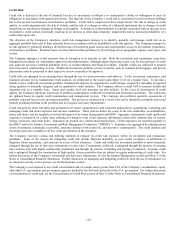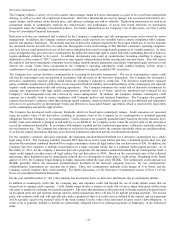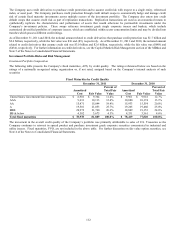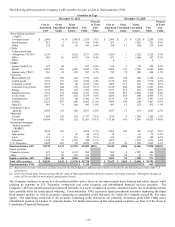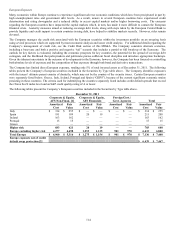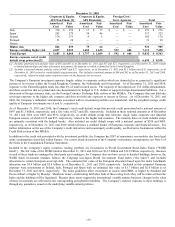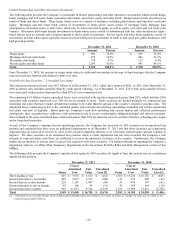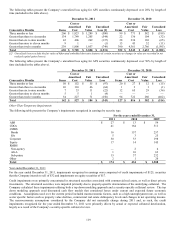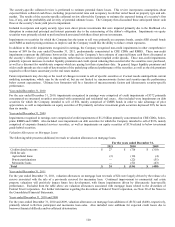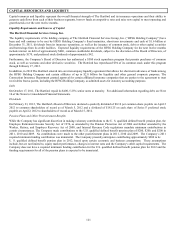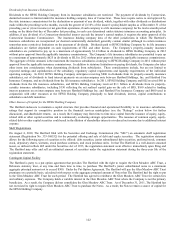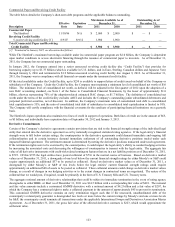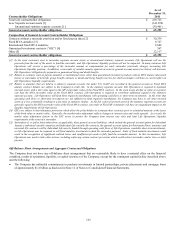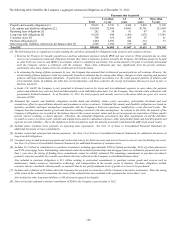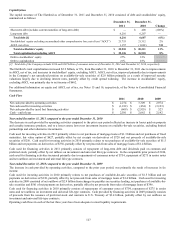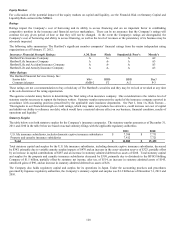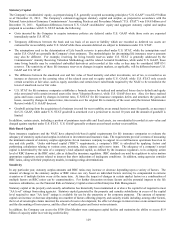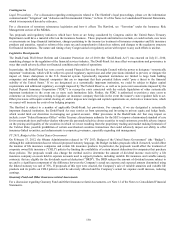The Hartford 2011 Annual Report Download - page 120
Download and view the complete annual report
Please find page 120 of the 2011 The Hartford annual report below. You can navigate through the pages in the report by either clicking on the pages listed below, or by using the keyword search tool below to find specific information within the annual report.
120
The security-specific collateral review is performed to estimate potential future losses. This review incorporates assumptions about
expected future collateral cash flows, including projected rental rates and occupancy levels that varied based on property type and sub-
market. The results of the security-specific collateral review allowed the Company to estimate the expected timing of a security’ s first
loss, if any, and the probability and severity of potential ultimate losses. The Company then discounted these anticipated future cash
flows at the security’ s book yield prior to impairment.
Included in corporate and equity security types were direct private investments that were impaired primarily due to the likelihood of a
disruption in contractual principal and interest payments due to the restructuring of the debtor’ s obligation. Impairments on equity
securities were primarily related to preferred stock associated with these direct private investments.
Impairments on securities for which the Company has the intent to sell were primarily on corporate bonds, certain ABS aircraft bonds
and CMBS as market pricing continues to improve and the Company would like the ability to reduce certain exposures.
In addition to the credit impairments recognized in earnings, the Company recognized non-credit impairments in other comprehensive
income of $89 for the year ended December 31, 2011, predominantly concentrated in CRE CDOs and RMBS. These non-credit
impairments represent the difference between fair value and the Company’ s best estimate of expected future cash flows discounted at
the security’ s effective yield prior to impairment, rather than at current market implied credit spreads. These non-credit impairments
primarily represent increases in market liquidity premiums and credit spread widening that occurred after the securities were purchased,
as well as a discount for variable-rate coupons which are paying less than at purchase date. In general, larger liquidity premiums and
wider credit spreads are the result of deterioration of the underlying collateral performance of the securities, as well as the risk premium
required to reflect future uncertainty in the real estate market.
Future impairments may develop as the result of changes in intent to sell of specific securities or if actual results underperform current
modeling assumptions, which may be the result of, but are not limited to, macroeconomic factors and security-specific performance
below current expectations. Ultimate loss formation will be a function of macroeconomic factors and idiosyncratic security-specific
performance.
Year ended December 31, 2010
For the year ended December 31, 2010, impairments recognized in earnings were comprised of credit impairments of $372 primarily
concentrated on structured securities associated with commercial and residential real estate. Also included were impairments on debt
securities for which the Company intended to sel1 of $54, mainly comprised of CMBS bonds in order to take advantage of price
appreciation, as well as impairments on equity securities of $8 primarily on below investment grade securities depressed 20% for more
than six months.
Year ended December 31, 2009
Impairments recognized in earnings were comprised of credit impairments of $1.2 billion primarily concentrated on CRE CDOs, below-
prime RMBS and CMBS. Also included were impairments on debt securities for which the Company intended to sell of $156, mainly
comprised of corporate financial services securities, as well as impairments on equity securities of $136 related to below investment
grade hybrid securities.
Valuation Allowances on Mortgage Loans
The following table presents (additions)/reversals to valuation allowances on mortgage loans.
For the years ended December 31,
2011
2010
2009
Credit-related concerns
$
27
$
(70)
$
(310)
Held for sale
Agricultural loans
(3)
(10)
(4)
B-note participations
—
(22)
(51)
Mezzanine loans
—
(52)
(43)
Total
$
24
$
(154)
$
(408)
Year ended December 31, 2011
For the year ended December 31, 2011, valuation allowances on mortgage loan reversals of $24 were largely driven by the release of a
reserve associated with the sale of a previously reserved for mezzanine loan. Continued improvement in commercial real estate
property valuations will positively impact future loss development, with future impairments driven by idiosyncratic loan-specific
performance. Excluded from the table above are valuation allowances associated with mortgage loans related to the divestiture of
Federal Trust Corporation. For further information regarding the divestiture of Federal Trust Corporation, see Note 20 of the Notes to
the Consolidated Financial Statements.
Years ended December 31, 2010 and 2009
For the years ended December 31, 2010 and 2009, valuation allowances on mortgage loan additions of ($154) and ($408), respectively,
primarily related to B-Note participant and mezzanine loan sales. Also included were additions for expected credit losses due to
borrower financial difficulty and/or collateral deterioration.


